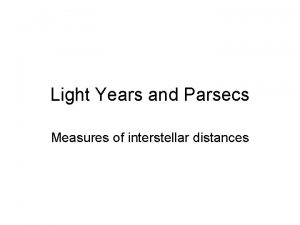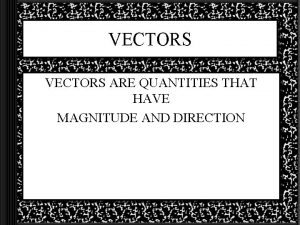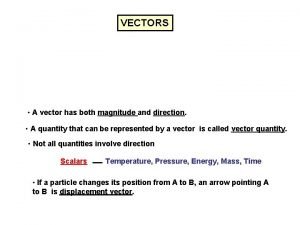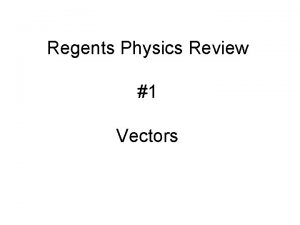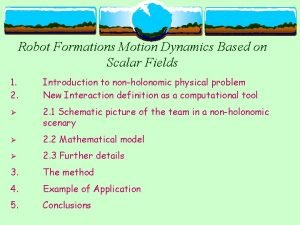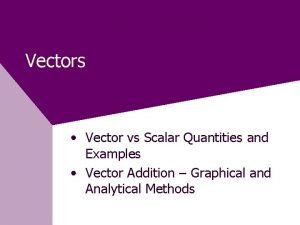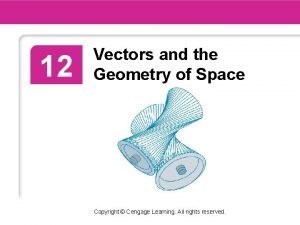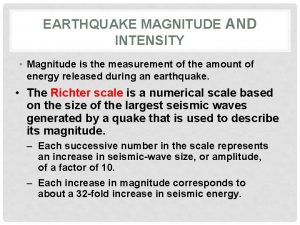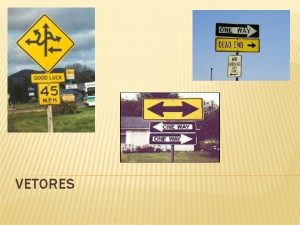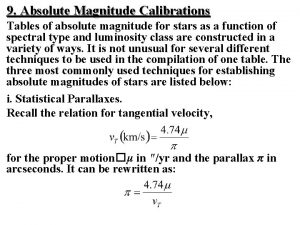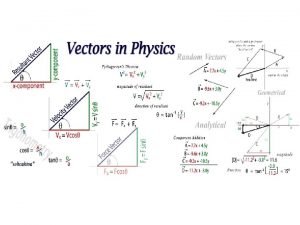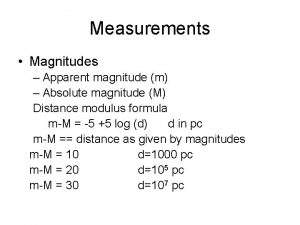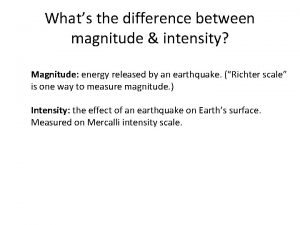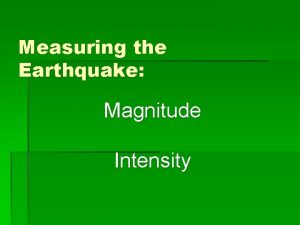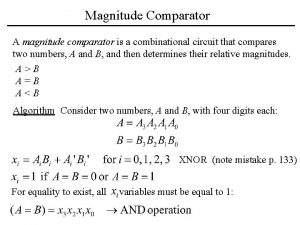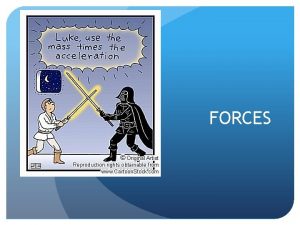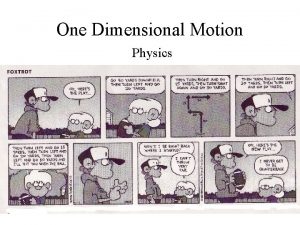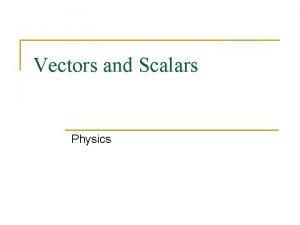Scalar a measurement that has only a magnitude









































- Slides: 41

Scalar: a measurement that has only a magnitude (amount) Vector: a measurement that includes both magnitude and direction


Why are these important? What about objects that more in multiple directions? Consider a parked car, parked nose in, in a parking spot. What gear do you put the car in first if you want to leave the parking lot? What direction does your car move? Is this positive or negative? Then you put the car in drive, or a low gear. What direction will you move now? Positive or Negative?

Practice Problem: Consider a female student seated at the center of the room. If she stands up and walks to the front of the room 10 m away and turns in an assignment, what is the total distance traveled? What is her displacement? Now consider the same female student. She walks 10 m to the front of the room, turns in her work and turns and walks back to the seat. Now what is the total distance traveled? Now tell me the distance the has traveled from her seat. This is her displacement.

So sometimes a vector measurement like displacement will be the same as its scalar counterpart, but sometimes it will be very different.

In the discovery assignment we learned the following relationships between the mechanics variables: Time proceeds independently of motion. Velocity is the change in displacement divided by the time period during which that change occurs. This is also called the rate of change of displacement. Acceleration is the change in velocity divided by the time period during which that change occurs. This is also called the rate of change of velocity. A rate of change is the same thing as the slope on a graph. So the SLOPE of the DISPLACEMENT graph is the VELOCITY and the SLOPE of the VELOCITY graph is the ACCELERATION.

Sir Issac Newton developed an entire system of mathematics to describe his observations of the physical world. We call this mathematics CALCULUS. Calculus allows us to calculate the instantaneous rates of change of velocity and acceleration.

Average velocity: Velocity over a period of time Average acceleration: Acceleration over a period of time As t approaches zero, the average rate of change approaches the instantaneous rate of change.

Motion Graphing Why do we use/analyze graphs representing motion? 1) Graphs represent a relationship between two or more variable quantities. • In mathematics you have treated “variables” as merely unknowns to be identified. In physics any variable is actually a quantity or a measurement of something real!

2) In physics, as in science generally, one of the most studied types of relationships between variables is that of time dependency, which is easily demonstrated by a 2 -D graph. 3) Often, the information that is highly evident on a graph of motion can only be proven quantitatively after many, and sometimes intensive calculations.

Graphs All graphs should have… • A title • Clearly defined axes, labeled with measurement units. • Gradations on the axes are usually helpful, but not necessary as long as any critical points are identifiable. • NO LINES CONNECTING DATA POINTS unless the data is continuous. • Thought given to what the slope (rise/run or y-values/x-values) means.

• Independent variable(s): ________________________________________ • Dependent variable(s): ________________________________________ Which axis goes with each? When considering motion what do you think will be the most common independent variable?

Motion Graphs • Before we look at some real types of examples mentally recall the fundamental mechanics variables (x, v, a, t) and how they relate to each other. If you’re not sure yet about that last part, hopefully it will become clear soon. • One caveat: Just because you are looking at a graph that may show, say, displacement vs. time, this does not preclude the fact that other information (about say, velocity or acceleration) may be available in that graph!

Assume the origin represents a reference time (t=0) at a reference point in space (x=0). Identify and describe any critical points on the graph. When describing the motion represented on a graph during the time between any consecutive critical points there are 2 questions to ask: 1) Is the object moving forwards or backwards (with respect to the origin or starting point)? 2) Is the rate of movement the same? OR, said another way: Is the object speeding up or slowing down?

ANOTHER EXAMPLE Notice the slope of the displacement graph… it’s a constant because the graph is a straight line, right? x v t a t Now look at the acceleration graph…recall that acceleration is the slope, or rate of change, of the velocity graph. What is the slope of a horizontal line? t

Based on the displacement or velocity graphs alone, it is possible to determine the other characteristics of motion for the object. x t Describe the behavior of the particle during each time interval

V t Describe the behavior of the particle during each time interval

Straight lines on a graph are easy. When curves are present, it becomes a little harder to interpret the motion.




v This graph looks familiar, but actually represents motion that is very different than the earlier graph of x vs. t. tt On a velocity vs. time graph, the area under the curve, or the integral, tells the displacement of the object for the designated time interval.

On an acceleration vs. time graph the area under the graph tells the average velocity during that time period. Notice how the area relationships are sort-of opposite to the slope relationships we discussed earlier. In calculus, the slope (derivative) is the opposite of the area (integral).

Velocity Acceleration + + + - - Description

x Slope Area “under” graph v Area “under” graph Slope a

Definitions commonly used in this class: • Displacement: x • Velocity: v The average change in displacement over a given time interval. Commonly written as an equation: • Acceleration: a The average change in velocity over a given time interval. Commonly written as an equation: Note the similarity to a “slope” calculation

Basic Mechanics Problems 1. Find the velocity of a car that accelerates at 10 m/s 2 from rest for 5 seconds. 2. Find the velocity of a thrown baseball that travels 75 m in a time of 1. 5 s. 3. A girl starts at her front door, walks to her mailbox 30 m forward in a time of 5 seconds, pauses for 3 seconds, turns and walks back to the door in 4 seconds. a) What is her velocity during the trip to the mailbox? b) From the mailbox? c) During the whole trip?

Free fall is just a special case of motion in which an object undergoes a constant acceleration, in this case due to gravity. Gavitational Acceleration has a constant value that you must MEMORIZE. Close to 10…use 10 for approximating, but use 9. 8 when you have a calculator. The negative sign indicates direction. Sometimes it is O. K. to ignore the sign, but you must always be aware of and indicate the direction of gravitational pull as downwards.

Advanced mechanics equations… Recall: Assuming motion in only 1 direction, say forward, from a relative zero position we can re-write this equation as: Or more generally: Where x is the total displacement and x 0 is the initial (non-zero) displacement.

Displacement under constant acceleration If we add an acceleration factor, after a little bit of calculus we get: If x 0 is zero, this simplifies to: When dealing with free fall and later, projectiles, displacement is in the vertical direction. This equation allows us to easily find the hang time of an object in the air.

More on velocity… Recall: Assuming motion in only 1 direction, say forward, from a relative zero initial velocity we can re-write this equation as: Or more generally: Where v is the final velocity and v 0 is the initial (non-zero) velocity. “t” represents the time interval in question.

Last one… What if you don’t know anything about time? Can you still relate the variable? Sure…a little algebraic manipulation of our other equations and… Remember that “x” here is the displacement or net distance. If you don’t start from a “zero” position, caution must be taken when using this equation.

So, given any combination of variables, x, v, a, & t, we can basically solve for any of the others, provided that we know enough to begin with. assumes a = 0 doesn’t need vfinal doesn’t need x doesn’t need t

REMEMBER: Acceleration is assumed to be CONSTANT in order for these relationships to hold true. An acceleration of “zero” is a special case of a constant acceleration.

Practice 1. A batter hits a baseball straight upwards with an initial velocity of 35 m/s. Find the maximum height of the ball, the time it takes to reach this height and the total time of flight. 2. A car accelerates from rest at 5 m/s 2. What is the velocity of the car as it passes the 55 m mark? What if the car had started rolling with an initial velocity of 3 m/s? Now what is the final velocity? 3. A clay pigeon thrower tosses a clay bird 45 m straight upwards. If it took the pigeon 3 s to reach this height, find the initial velocity of the disk. (hint: WATCH YOUR SIGNS) 4. A madman throws a bowling ball upwards from the roof of a 40 m tall office building. If it impacts the ground with a velocity of 31 m/s, determine how high above the building it rose.

Inertial Frames of Reference • We often describe motion in terms of a static frame of reference. That is to say, we consider it as if we were a passive observer, standing stationary with respect to the action. • Most real life situations involve dynamic, moving frames of reference. For instance, if you are driving a race car, you are probably not concerned with the speed of a passing car, but more likely concerned with how much faster it is traveling than you are. Using your inertial frame of reference this can be easily determined.

• The frame of reference often serves as a starting point, used to determine initial, relative velocities. Once these are known, your kinematics equations kick in and everything proceeds normally. • Caution: Frames of reference are only important to consider when two moving objects are present, OR when a problem asks you to place yourself within the system defined by the problem (i. e. , use your imagination).

Example: • You are a bug, clinging for life to a baseball that has just been wacked straight up. The ball reaches its maximum height and then… – Why are you on the ball? IRRELEVANT – Why is the ball going straight up? B/c Most you can’t handle a 2 -D motion problem yet…patience. • As the ball falls, describe the rate at which the ground approaches you. • What is the rate at which you approach the ground?

Example 2: • A miscreant teenager in the passenger side of a pickup truck (yee-haw!) fires a paintball gun at an old lady standing by her mailbox. If the truck is traveling at 25 m/s, and the paintball is fired at 90 m/s, neglecting air resistance what is the velocity of the paintball upon impacting the old woman? • What is the velocity of the paintball with respect to the truck?

• Same problem, paintball fired at an oncoming jogger, vjogger=3 m/s. Find velocity of the paintball w/r to the jogger. • Jogger going away at 3 m/s. Find velocity of paintball w/r to jogger.

Trains, Planes and Automobiles • Common problem type: – Two trains, A & B, approach head on. Each train has velocity V as determined by a stationary observer. What is the velocity of train A • With respect to the ground? • With respect to train B? – Two trains, A & B, travel side-by-side. Train A has velocity V and train B has velocity 3 V, determined by a stationary observer. What is the velocity of train A with respect to train B?
 Scalar quantity has only
Scalar quantity has only Scalar versus vector
Scalar versus vector Parsecs to light-years
Parsecs to light-years Distance is a scalar
Distance is a scalar Tìm vết của đường thẳng
Tìm vết của đường thẳng Sau thất bại ở hồ điển triệt
Sau thất bại ở hồ điển triệt Thơ thất ngôn tứ tuyệt đường luật
Thơ thất ngôn tứ tuyệt đường luật Con hãy đưa tay khi thấy người vấp ngã
Con hãy đưa tay khi thấy người vấp ngã Thơ thất ngôn tứ tuyệt đường luật
Thơ thất ngôn tứ tuyệt đường luật Tôn thất thuyết là ai
Tôn thất thuyết là ai Ngoại tâm thu thất chùm đôi
Ngoại tâm thu thất chùm đôi Walmart thất bại ở nhật
Walmart thất bại ở nhật Gây tê cơ vuông thắt lưng
Gây tê cơ vuông thắt lưng Block av độ 2
Block av độ 2 Magnitude of vector
Magnitude of vector Both magnitude and direction
Both magnitude and direction Take only photos leave only footprints
Take only photos leave only footprints Business has only two functions marketing and innovation
Business has only two functions marketing and innovation Monocot apomorphies
Monocot apomorphies 1000 species of finch have been identified
1000 species of finch have been identified A storm system moves 5000 km due east
A storm system moves 5000 km due east Moment of a couple formula
Moment of a couple formula What is velocity
What is velocity Scalars and vectors
Scalars and vectors Is projectile motion a scalar or vector
Is projectile motion a scalar or vector The diagram below shows a toy cart possessing 16 joules
The diagram below shows a toy cart possessing 16 joules Components of vectors
Components of vectors Persamaan bidang melalui 3 titik
Persamaan bidang melalui 3 titik Scalar robot
Scalar robot Hasil kali skalar dengan vektor
Hasil kali skalar dengan vektor Force is the integral of potential energy
Force is the integral of potential energy Skew matrix example
Skew matrix example Dot product
Dot product Example of vector
Example of vector Integral luas permukaan
Integral luas permukaan Moment couple formula
Moment couple formula Vectors and the geometry of space
Vectors and the geometry of space Scalar kalman filter
Scalar kalman filter Units, physical quantities, and vectors
Units, physical quantities, and vectors Scalar field
Scalar field Kinetic energy scalar
Kinetic energy scalar Simple scalar
Simple scalar


